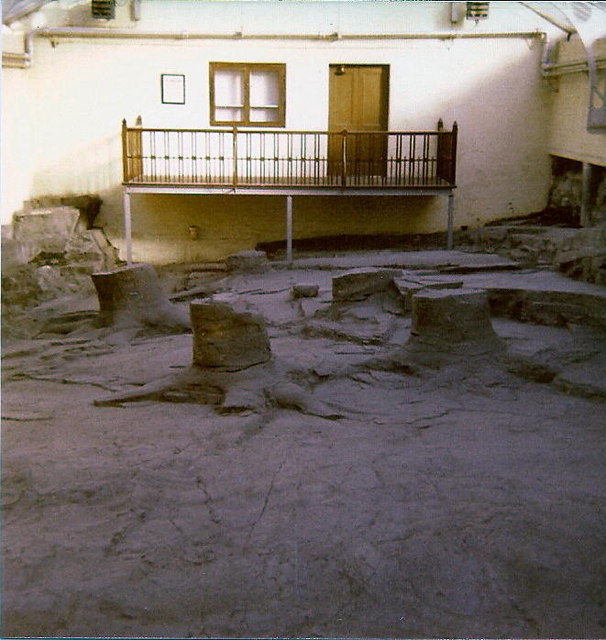|
Wendelstein (mountain)
Wendelstein is a mountain in the Bavarian Alps in South Germany. It is part of the Mangfall Mountains, the eastern part of the Bavarian Pre-Alps, and is the highest peak in the Wendelstein massif. It lies between the valleys of the Leitzach and Inn and is accessible via the Wendelstein Cable Car and the Wendelstein Rack Railway. On its northern foothills rises the Jenbach, which becomes the Kalten on its way to the River Mangfall. Local valley settlements include Bayrischzell, Brannenburg and Osterhofen. Geography Geology The mountain consists mainly of Wetterstein limestone from the Upper Triassic with dasycladales - marine algae whose natural habitat is shallow lagoons in tropical climates. The colour of the rock varies between grey white and light grey to speckled. File:Wendelstein von Westen-1.jpg, The Wendelstein seen from the west File:Wendelstein Nov2011.jpg, The Wendelstein from the south File:Wendelstein Transmitter.jpg, Wendelstein's BR transmission mast File:We ... [...More Info...] [...Related Items...] OR: [Wikipedia] [Google] [Baidu] |
Breitenstein (mountain)
Breitenstein is a 1,622 m high mountain of the Bavarian Prealps. Minimum altitude 627 m Altitude difference 1023 m Normal routes The most common route is from Fischbachau to the Kesselalm continuing via the Hubertushütte to the summit. Mountains of Bavaria Mountains of the Alps The route to the mountain is popular and can get quite crowded on weekends {{Bavaria-geo-stub ... [...More Info...] [...Related Items...] OR: [Wikipedia] [Google] [Baidu] |
Mangfall
The Mangfall () is a river of Upper Bavaria, Germany. It is a left tributary of the Inn. The Mangfall is the outflow of the Tegernsee lake and discharges into the Inn in Rosenheim. The Mangfall is long. Towns and villages on the Mangfall * Gmund am Tegernsee * Valley * Weyarn * Grub (district of Valley) * Feldkirchen-Westerham * Feldolling * Bruckmühl * (district of Bruckmühl) * (district of Bruckmühl) * Bad Aibling * Kolbermoor * Rosenheim See also *List of rivers of Germany **List of rivers of Bavaria A list of rivers of Bavaria, Germany: A * Aalbach * Abens * Ach * Afferbach * Affinger Bach * Ailsbach * Aisch * Aiterach * Alpbach *Alster * Altmühl * Alz * Amper * Anlauter * Arbach * Arbachgraben * Aschaff * Aschbach * Attel * Aubach, tributa ... References External links bike trail along the MangfallFlux of the Mangfall in Rosenheim during the last 30 days {{Authority control Rivers of Bavaria Miesbach (district) Rosenheim (district) Rivers of ... [...More Info...] [...Related Items...] OR: [Wikipedia] [Google] [Baidu] |
Otto Von Steinbeis
Otto is a masculine German given name and a surname. It originates as an Old High German short form (variants ''Audo'', '' Odo'', '' Udo'') of Germanic names beginning in ''aud-'', an element meaning "wealth, prosperity". The name is recorded from the 7th century ( Odo, son of Uro, courtier of Sigebert III). It was the name of three 10th-century German kings, the first of whom was Otto I the Great, the first Holy Roman Emperor, founder of the Ottonian dynasty. The Gothic form of the prefix was ''auda-'' (as in e.g. '' Audaþius''), the Anglo-Saxon form was ''ead-'' (as in e.g. '' Eadmund''), and the Old Norse form was '' auð-''. Due to Otto von Bismarck, the given name ''Otto'' was strongly associated with the German Empire in the later 19th century. It was comparatively frequently given in the United States (presumably in German American families) during the 1880s to 1890s, remaining in the top 100 most popular masculine given names in the US throughout 1880–1898, but its ... [...More Info...] [...Related Items...] OR: [Wikipedia] [Google] [Baidu] |
Bayerischer Rundfunk
(; "Bavarian Broadcasting"), shortened to BR (), is a public broadcasting, public-service radio and television broadcaster, based in Munich, capital city of the Bavaria, Free State of Bavaria in Germany. BR is a member organization of the ARD (broadcaster), ARD consortium of public broadcasters in Germany. History Bayerischer Rundfunk was founded in Munich in 1922 as Deutsche Stunde in Bayern. It aired its first program on 30 March 1924. The first broadcasts consisted mainly of time announcements, news, weather and stock market reports, and music. Programming expanded to include radio plays, concerts, programs for women, language courses, chess, opera, radio, news, and Catholic and Protestant morning services. Its new 1929 studio was designed by Richard Riemerschmid. Deutsche Stunde in Bayern became Bayerischer Rundfunk in 1931. In 1933, shortly after the Nazi seizure of power, the station was put under the control of the Reich Ministry of Public Enlightenment and Propaganda. A ... [...More Info...] [...Related Items...] OR: [Wikipedia] [Google] [Baidu] |
Geopark
A geopark is a protected area with internationally significant geology within which Sustainability, sustainable development is sought and which includes tourism, conservation, education and research concerning not just geology but other relevant sciences. In 2005, a European Geopark was defined as being: "a territory with a particular geological heritage and with a sustainable territorial development....the ultimate aim of a European Geopark is to bring enhanced employment opportunities for the people who live there." Today the geopark is virtually synonymous with the UNESCO geopark, which is defined and managed under the voluntary authority of UNESCO's International Geoscience Programme, International Geoscience and Geoparks Programme (IGGP). UNESCO provides a standard for geoparks and a certification service to territories that apply for it. The service is available to member states of UNESCO. The list of members is not the same as the member states of the United Nations. Memb ... [...More Info...] [...Related Items...] OR: [Wikipedia] [Google] [Baidu] |
World Meteorological Organisation
The World Meteorological Organization (WMO) is a specialized agency of the United Nations responsible for promoting international cooperation on atmospheric science, climatology, hydrology and geophysics. The WMO originated from the International Meteorological Organization (IMO), a nongovernmental organization founded in 1873 as a forum for exchanging weather data and research. Proposals to reform the status and structure of the IMO culminated in the World Meteorological Convention of 1947, which formally established the World Meteorological Organization. The Convention entered into force on 23 March 1950, and the following year the WMO began operations as an intergovernmental organization within the UN system. The WMO is made up of 193 countries and territories, and facilitates the "free and unrestricted" exchange of data, information, and research between the respective meteorological and hydrological institutions of its members. It also collaborates with nongovernmenta ... [...More Info...] [...Related Items...] OR: [Wikipedia] [Google] [Baidu] |
German Met Office
The () or DWD for short, is the German Meteorological Service, based in Offenbach am Main, Germany, which monitors weather and meteorological conditions over Germany and provides weather services for the general public and for nautical, aviation, hydrometeorological or agricultural purposes. It is attached to the Federal Ministry for Transport. The DWDs principal tasks include warning against weather-related dangers and monitoring and rating climate changes affecting Germany. The organisation runs atmospheric models on their supercomputer for precise weather forecasting. The DWD also manages the national climate archive and one of the largest specialised libraries on weather and climate worldwide. History The DWD was formed on 11 November 1952 when the weather services of the western occupation zones were merged. In 1954, the Federal Republic of Germany joined the World Meteorological Organization (WMO). In 1990, following the reunification, the weather services of the German ... [...More Info...] [...Related Items...] OR: [Wikipedia] [Google] [Baidu] |
Precipitation (meteorology)
In meteorology, precipitation is any product of the condensation of atmospheric water vapor that falls from clouds due to gravitational pull. The main forms of precipitation include drizzle, rain, rain and snow mixed ("sleet" in Commonwealth usage), snow, ice pellets, graupel and hail. Precipitation occurs when a portion of the atmosphere becomes saturated with water vapor (reaching 100% relative humidity), so that the water condenses and "precipitates" or falls. Thus, fog and mist are not precipitation; their water vapor does not condense sufficiently to precipitate, so fog and mist do not fall. (Such a non-precipitating combination is a colloid.) Two processes, possibly acting together, can lead to air becoming saturated with water vapor: cooling the air or adding water vapor to the air. Precipitation forms as smaller droplets coalesce via collision with other rain drops or ice crystals within a cloud. Short, intense periods of rain in scattered locations are called shower (p ... [...More Info...] [...Related Items...] OR: [Wikipedia] [Google] [Baidu] |
WENDELSTEIN WEWA Nieder
Wendelstein may refer to: * Wendelstein (mountain), a mountain in the Chiemgau * Wendelstein, Bavaria, a town in the district of Roth in Bavaria, Germany * two experimental stellarators (nuclear fusion reactors) of the Max-Planck-Institut für Plasmaphysik: ** The Wendelstein 7-AS is located in Garching near Munich, Germany ** Its successor, the Wendelstein 7-X The Wendelstein 7-X (abbreviated W7-X) reactor is an experimental stellarator built in Greifswald, Germany, by the Max Planck Institute for Plasma Physics (IPP), and completed in October 2015. [...More Info...] [...Related Items...] OR: [Wikipedia] [Google] [Baidu] |
Habitat
In ecology, habitat refers to the array of resources, biotic factors that are present in an area, such as to support the survival and reproduction of a particular species. A species' habitat can be seen as the physical manifestation of its ecological niche. Thus "habitat" is a species-specific term, fundamentally different from concepts such as Biophysical environment, environment or vegetation assemblages, for which the term "habitat-type" is more appropriate. The physical factors may include (for example): soil, moisture, range of temperature, and Luminous intensity, light intensity. Biotic index, Biotic factors include the availability of food and the presence or absence of Predation, predators. Every species has particular habitat requirements, habitat generalist species are able to thrive in a wide array of environmental conditions while habitat specialist species require a very limited set of factors to survive. The habitat of a species is not necessarily found in a ge ... [...More Info...] [...Related Items...] OR: [Wikipedia] [Google] [Baidu] |
Dasycladales
Dasycladales is an Order (biology), order of large unicellular green algae in the class Ulvophyceae. It contains two families, the Dasycladaceae and the Polyphysaceae. These single celled algae are from 2 mm to 200 mm long. They live on substrates in shallow warm (>20 °C) euhaline tropical marine waters, usually less than 20 meters deep, and protected from waves. They are very large cells. They are able to attain these sizes without numerous internal cell wells because they build calcium carbonate shells around themselves. They contain only one Cell nucleus, nucleus in their vegetative stage, which remains in the bottom of the cell in the holdfast (biology), holdfast at the substrate. Only when they are ready to produce gametes does the nucleus undergo meiosis and then numerous mitosis, mitoses into many nuclei which then migrate into the gametangia at the top of the alga. Because the nucleus is safely hidden in the holdfast, the cells easily regenerate if t ... [...More Info...] [...Related Items...] OR: [Wikipedia] [Google] [Baidu] |




